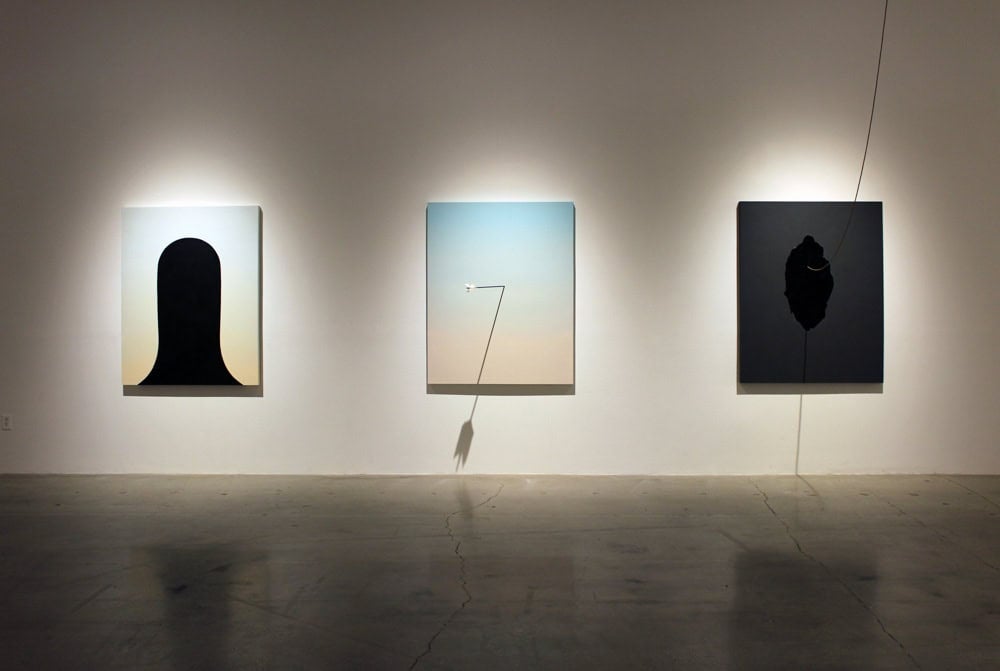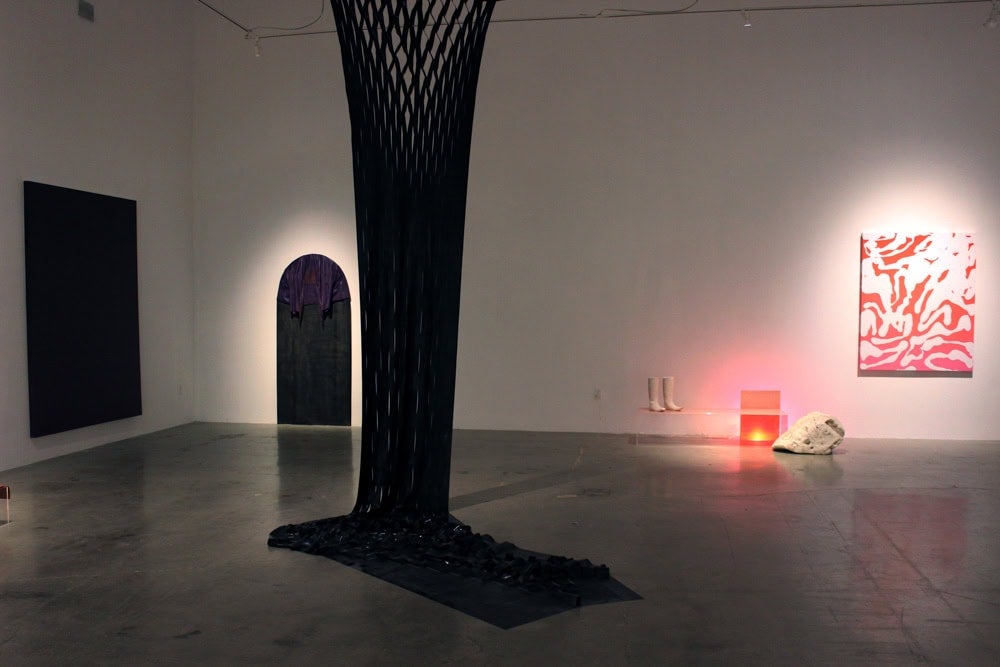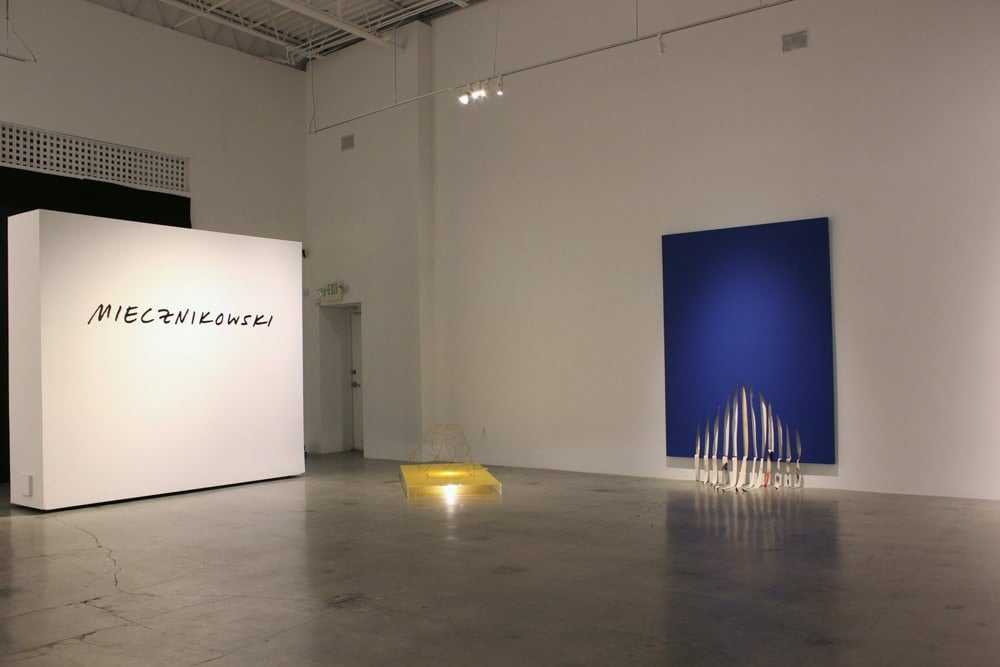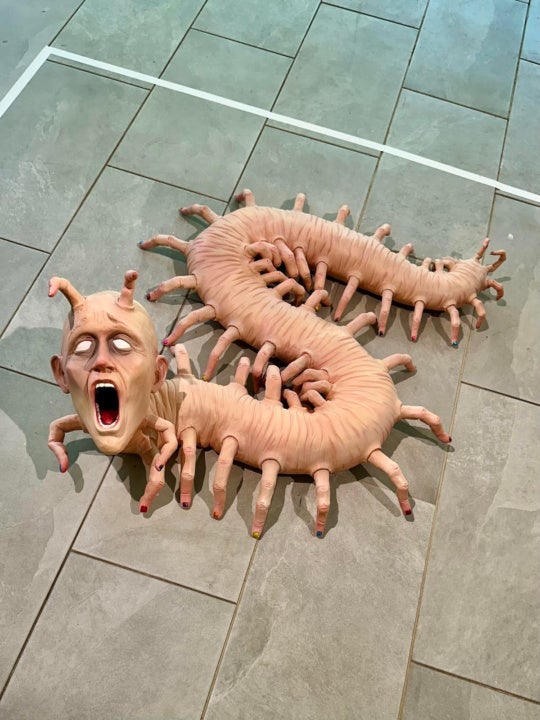
“Miecznikowski” is Kirstin Mitchell’s original family name, and the name of her Working Artist Project exhibition at the Museum of Contemporary Art of Georgia through September 8. It was the Polish family name of her father, whose approaching death shaped the trajectory of this show without determining its content.
This body of work (emphasis on “body”) resists reductionism at every turn even as it exploits reductionists’ expectations, keeping the meanings multilayered always—and this is a strategy that Mitchell has always employed, from her earlier performance work as Kiki Blood to her playfully transgressive subversions of the decorative in 2017’s “Midnight at the Oasis” at Hathaway Gallery. If “Miecznikowski” is on one level an exploration of what Mitchell calls “narratives of lineage outside of tradition,” it is also a deeply serious, antic collision of contrasting or contradictory textures, emotions, and artistic genres in the service of self-revelation. As Mitchell writes in her artist’s statement: “Pleasure dances across this body of work alongside humor, longing and exposure.”

That said, this is visually and symbolically a very coherent exhibition, with a few carefully situated interruptions. So it’s best to start with the most conspicuous of these, a trio of representational paintings that stretch expressionist gesture to the limit. A Landscape Lollipop leans against the wall behind an aptly named Porn Chair that seems like a nod to Mitchell’s years of confrontational performance, while an enormous portrait incorporating (as she describes it) frequently encountered Polish facial characteristics, with a blue disk attached over the iris of the eye, justifying the punning title Aqueous Humor for a painting that is, indeed, wittily watery and about vision on several different levels. The slightly transformed coveralls that hang next to this work allude to Mitchell’s working-class roots and to the working costume of a good many contemporary painters.
The frantic playfulness of this corner comports poorly with the symbolic shock of the trio of paintings to its left, which makes their level of metaphysical seriousness all the more arresting. Coming for You consists of an irregular black shape on a dark gray background, with a cord attached to the wood panel in the center of the semi-vaginal portal and stretching upwards towards the rafters of the gallery. The mythic and religious resonances are too numerous to cite, but all of them relate to death and transformation, whether physical, psychological, or spiritual. Flying Sword consists of an arrow piercing the center of a wood-panel painting, reprising the paradisally tropical pastel light of dawn that was a dominant feature in her 2017 exhibition. Here, the arrow from her performance as archer in 2015’s One Shot becomes the lethal weapon that, what, destroys the prematurely claimed innocence of paradise? kills illusion in general, as both shamans and Buddhists would have such instruments of seeming destruction do? The possible meanings are diverse and many. All we can do is note Mitchell’s discovery that “miecz” means “sword” in Polish, and this arrow is her flying sword.

Any suspicion that this is imposing psycho-spiritual interpretation on personal symbolism is dispelled by the painting, The Pinnacle of Sexes, in which the paradisal dawn is overlaid almost to the point of obliteration by a peculiarly shaped black void that is simultaneously phallic and womb-shaped. When queried, Mitchell explained that this is the Dhyanalinga form that revealed itself to the founder of Isha Yoga when he applied paint to a wall in a continuous brushstroke that suggested the continuum of matter and spirit (which is a notion with a history that lies beyond the confines of this review). This oddly bulbous image is a clue that leads to one strand of the ideas that lie behind Mitchell’s assertion that in this exhibition “the spiritual and the sexual often ask the same question of the viewer.”
After this, if we follow the path that Mitchell intends for us to follow, we are in for a swirling dance of opposites in which the personal and the universal rhyme more intricately than we might expect. Summer of Acid, a larger version of the disk that formed the blue iris of Aqueous Humor, lurks weightily atop the doorframe of the entrance to the adjacent gallery. An expressive pink and white painting, Topography, hangs next to Lightweight, an absurdist assemblage in which a girlish-pink lightbox illuminates a Styrofoam boulder and a pair of feet molded from plaster of paris. This rococo array sits next to a black fiberboard archway form crowned with a dark-purple fringed hanging made from a leather jacket; funereal in appearance, this piece is titled Minkowski Space, after a model of four-dimensional spacetime that is named for the Polish-named German physicist Hermann Minkowski. This paradoxically seriocomic piece forms a symbolic transition between childhood and the large dark void of the deliberately unlit black painting titled Buffalo, a direct allusion to Michell’s now-absent father who hailed from the city of Buffalo and who was the type of monumental presence such as might be summoned by the associations of the word “buffalo” and the 96-by-72-inch dimensions of the painting.

Viewed from across the gallery, this corner of darkness is intersected by the powerfully effective Chainmaile/Fishnet/Veil, a 16-by-6-foot sheet of black rubber hung from the rafters, with its patterned perforations suggesting, by turns, chainmail armor, fishnet stockings, and the black veil of mourning. It also hangs more or less in front of the adjacent equally powerful work, The Bridge of Sighs, a seductively rubber-sheeted catafalque with a scepter leaning against it, both complementing and negating yet another pastel-dawnlight painting, Fourteen, which hangs directly behind it. The combination is loaded with historical and psychosexual baggage resisting succinct explication.
Although the majority of the works in the exhibition make use of readily recognizable symbolism, the art historical references of the final painting, Swords, may be as opaque as the meaning of the wire basket on a yellow platform in the nearby sculpture Golden Plane. The slices cut from the bottom of the Yves-Klein-blue canvas, leaving voids shaped like sword blades, are Mitchell’s concluding riposte to observers who questioned her legitimacy as a painter after her long run as a performance artist.
The various works are designed to seduce different viewers differently, and the testimony of visitors to “Miecznikowski” indicates that they do exactly that. Given this knowledge, it is difficult for me to point to the very few moments of this show that feel unresolved to me (in Lightweight and Golden Plane). Since Mitchell has always been a consummate trickster as well as a deft explorer of both the depths and the shallows of the human psyche, even the infrequent flaws in her work are deliberate.




